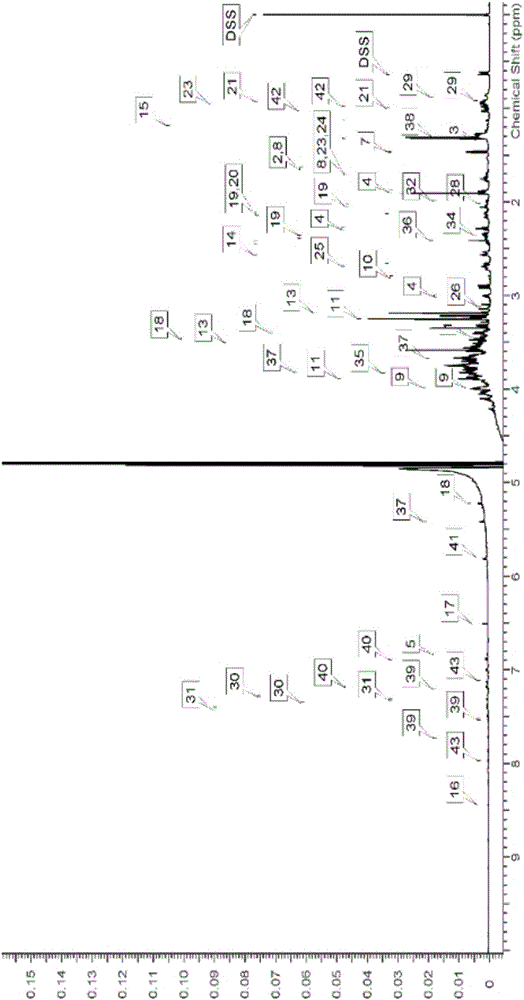Method for determining soybean seed vigor based on nuclear magnetic resonance technique
A soybean seed and nuclear magnetic resonance technology, applied in the field of analytical chemistry, can solve the problems of difficult to quickly achieve the expected purpose, time-consuming and laborious evaluation, long cycle and other problems, and achieve the effect of accurate measurement, reliable data and large contribution rate.
- Summary
- Abstract
- Description
- Claims
- Application Information
AI Technical Summary
Problems solved by technology
Method used
Image
Examples
Embodiment 1
[0065] In this embodiment, soybean and black soybean seeds of different years are selected, and the soybean seed sample information is shown in Table 1.
[0066] Table 1 Material information of samples
[0067] material code source harvest year Seed coat color JP6-H24 Hokkaido, Japan 2012 black beans JP6-H25 Hokkaido, Japan 2013 black beans JP16-H24 Hokkaido, Japan 2012 soy JP16-H26 Hokkaido, Japan 2014 soy
[0068] First, the four sample materials were ground and pulverized with liquid nitrogen and freeze-dried for 24 hours using a freeze dryer, and then the obtained soybean powder was stored in a -80°C ultra-low temperature refrigerator for later use.
[0069] Secondly, the analysis steps of the freeze-dried powder of each sample are as follows:
[0070] 1) Accurately weigh 500.0 mg of the freeze-dried powder of the soybean sample, place it in a sample tube, add 1 mL of methanol aqueous solution with a volume conce...
Embodiment 2
[0086] The soybean samples to be tested in this example were selected as the soybean sample JP16-H24 and the black soybean sample JP6-H24 purchased in 2012 as experimental materials, and the soybean seed sample information is shown in Table 3.
[0087]Table 3 Material information of two different soybeans
[0088] material code source harvest year Seed coat color JP6-H24 Hokkaido, Japan 2012 black beans JP16-H24 Hokkaido, Japan 2012 soy
[0089] First, the above two sample materials were ground and pulverized with liquid nitrogen and freeze-dried for 24 hours using a freeze dryer, and then the obtained soybean powder was stored in an ultra-low temperature refrigerator at -80°C for later use.
[0090] Secondly, the analysis steps of the freeze-dried powder of each sample are as follows:
[0091] 1) Accurately weigh 50.0 mg of the freeze-dried powder of the soybean sample, place it in a sample tube, add 1 mL of methanol aqueous solution w...
Embodiment 3
[0102] The same soybean material JP16 purchased in 2012 and 2014 was selected as the experimental sample for the soybean samples to be tested in this example, and the soybean seed sample information is shown in Table 5.
[0103] Table 5 Material information of two different soybeans
[0104] material code source harvest year Seed coat color JP16-H24 Hokkaido, Japan 2012 soy JP16-H26 Hokkaido, Japan 2014 soy
[0105] First, the above two sample materials were ground and pulverized with liquid nitrogen and freeze-dried for 24 hours using a freeze dryer, and then the obtained soybean powder was stored in an ultra-low temperature refrigerator at -80°C for later use.
[0106] Secondly, the analysis steps of the freeze-dried powder of each sample are as follows:
[0107] 1) Accurately weigh 50.0 mg of the freeze-dried powder of the soybean sample, place it in a sample tube, add 1 mL of methanol aqueous solution with a volume concentration of ...
PUM
 Login to View More
Login to View More Abstract
Description
Claims
Application Information
 Login to View More
Login to View More - R&D
- Intellectual Property
- Life Sciences
- Materials
- Tech Scout
- Unparalleled Data Quality
- Higher Quality Content
- 60% Fewer Hallucinations
Browse by: Latest US Patents, China's latest patents, Technical Efficacy Thesaurus, Application Domain, Technology Topic, Popular Technical Reports.
© 2025 PatSnap. All rights reserved.Legal|Privacy policy|Modern Slavery Act Transparency Statement|Sitemap|About US| Contact US: help@patsnap.com



